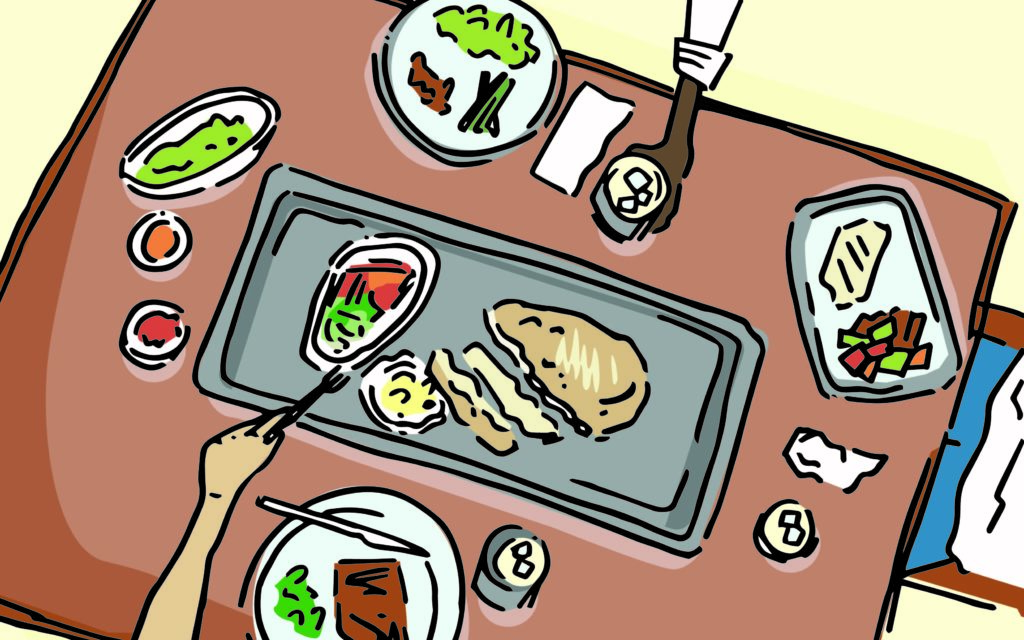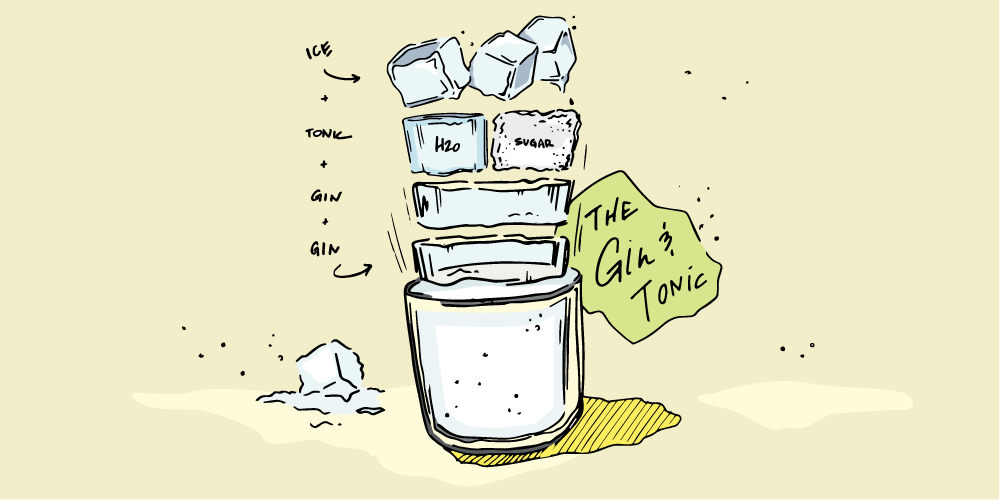“Your gin and tonic, Chef,” Ray says as he places the glass on the industrial stainless-steel countertop by the stove. “A double with plenty of ice.” I am tossing the pakchoi in the wok, flame snarling up the sides.
“Thanks, boss,” I say, without turning. Ray knows I’m very focused when cooking Chinese greens. Every second counts if they are going to be just right on this high heat. I plate the pakchoi, wiping away the spills on the dish’s rim as I savor the gin and tonic (G & T). Very fizzy and really cold. Perfect.
“Dinner will be ready in ten. Is the table ready, Boss?” I throw the beef into the fragrant sizzling garlic mince, before stealing another sip.
“On it now, Chef.”
Ten minutes later, I take off my apron, wipe my brow, and straighten my clothes. I take a swig of the drink in one hand, push the swing door with the other, and make my way to the dining area to join Ray and Gillian Lane who are waiting for me at the table with their own G & Ts. It’s always G & T for this party of friends.
I’m no chef, and Ray is actually the boss. He and his wife, Gill, own and run the Fisherbeck Hotel in Ambleside in the English Lake District. I’ve been coming to visit them annually for the past nine years since Raja, my husband died. We were living in London and had rented one of their holiday cottages by the hotel two weeks before Raja went in for open-heart surgery, from which he died of complications ten days later. We had many enjoyable evenings with the Lanes that week. They were devastated by the news of his death and we stayed in touch. Every year I visit them from my new home in Boston and cook every day. Sometimes lunch too, reinventing the leftovers, when I am not out exploring the expansive rugged terrain.
“We love it when you come. We feel like we are on holiday,” they told me one day. “We don’t have to worry about our meals and we get to eat Indian curries and Chinese stirfries and spicy Malay dishes which we can’t get up here.”
And I love it too because I get to experiment with new recipes, as well as refurbish decades-old ones. It’s the only time I get to cook for anyone these days, actually.
I get a kick out of cooking in their industrial kitchen — there was a restaurant once but now it’s just used for preparing made-to-order English breakfasts for hotel guests. The microwave is super powerful — we’re talking seconds, not minutes, to warm a bowl of rice before it turns to toast. The gas burners are double-stacked for a 15,000 BTU sear — perfect for Asian cooking. It was Ray, who also loves to cook, who acquainted me with cooking with a drink in hand — very posh. Like they do it in the movies. But the best part of the trip is spending time with the Lanes in the evenings when the laundry, housekeeping, and dinner are done and we adjourn to the family room by the reception where Penny (Lane) the brown-and-white Jack Russell sits in her favorite chair and eavesdrops on our conversations. On one of those evenings, Gill introduced me to the G & T.

I had often wondered about that drink. It’s what my English friends order wherever they are out in the world. When we were living in Paris, Sue Ellwood needed a G & T whenever she was stressed. Or happy. John and Julie in Manila ordered it when we were out for drinks. The Lanes have one before dinner and possibly a second one afterward if they have friends over. It’s ubiquitous in English novels and tv shows: James Bond may appear on screen with his vodka martinis, but in Ian Fleming’s books, Bond and other characters also order G & Ts. Likewise in Downton Abbey. Queen Elizabeth II is a gin fan and has been photographed with one in hand. Buckingham Palace recently launched its own small batch of London dry gin.
Ray came around to get orders for post-dinner drinks. “We are having G & Ts. What would you like?”
“What’s that like?”
“Try it,” Gill said.
I took a cautious sip. It was surprisingly subtle, easier to drink than a vodka cocktail or a brandy, neat. I took another sip and let it rest on my tongue, recalling how Raja tasted a new bottle of wine. “Very nuanced. Crisp. Hint of lavender?” I said slowly, trying to decipher familiar notes. “Citrus-y.”
“It’s the botanicals,” Gill said and explained that gin is made from a base white spirit that is flavored with botanicals which must include juniper. “And the bitter taste is from the quinine in the tonic water.”
I was thrilled to discover a drink so perfectly balanced and refreshing. Definitely a drink I’d like to have again. I asked them how to make one.
“A standard measure of gin i.e. 1 oz, onto ice in a tall glass and topped up with 4 oz of tonic water. Then, garnish it with a slice of lemon or lime,” Ray said.
Gill quickly added: “Be careful. In the U.S., they use a 2 oz measure as standard, which is a double here in England.” She would know. They lived in New York for 20 years when Ray was an antique dealer specializing in English pottery and porcelain of the 18th and early 19th centuries. “You don’t want to have a double without practice.”
That night, I called Joe Pereira, an old English friend whom Raja and I got to know very well when we all lived in Jakarta in 1999. Joe was in the hospitality business and knew just about everything about food and beverage. When I was reviewing a new restaurant for The Jakarta Post, I often brought him along. I remember him ordering G & Ts whenever we were out together.
“Hey, Joe. Guess what? I just discovered G & T and I love it.” I heard him chuckle on the other side.
“Finally. I wondered when you were going to get to it!”
“How come Raja and I never discovered G & T all these years?”
“When you were living in France, the wine took center stage obviously. I remember Raja loved his Bordeaux. You didn’t care for wine — except for champagne, you snob! But you liked everything sparkling so I’m not surprised you like G & T. Then when you guys were in Brussels, beer was the thing. The pint-sized country has over 1000 varieties. However, Raja still held on to his wine — beer made him feel stuffed. While you just wanted the chocolates.”
“Mais oui,” I agreed.
“Raja loved his wine so much he stuck with it even after you guys moved to London and stayed for almost ten years — G & T had no chance at all. He’s a loyal one-drink guy. You’ve never much cared for any particular alcoholic drink but it sounds like you’ve been smitten by the G & T.”
I thought Joe captured our drinking preferences succinctly and wondered what Raja would have thought of Joe’s analysis.
I asked Joe about the origin of G & T, especially the quinine in the tonic which is an anti-malarial drug that I was familiar with growing up in Malaysia with mosquito-borne diseases. G & T is so popular with the English. Presumably, it was invented in England?
“No. In India, actually. Tonic, as you know, is simply quinine and sugar in water. During the Raj, British soldiers were required to ingest the horribly bitter quinine as an anti-malarial. It was difficult to swallow even after adding water and sugar to it. Then they discovered that a shot of gin would make it easier to consume.”
I bet they did. Then they brought it back to England and G & T became part of British culture. But why is a measure of gin called a “shot”?
According to Joe, legend has it that a “shot” originated in the Wild West. When a cowboy didn’t have money, he paid for his drink with a bullet which was about the price of a drink. But that myth has since been debunked. More likely, it refers to the manner of pouring the drink. That sudden jerking movement when the spirit shoots from the bottle into the glass. It was also a word for the tab in a pub in the 15th century. Such as: “He paid my shot.”
“Take it slow,” Joe insisted, before he said good night. “Raja’s not around to look out for you. So, no double shots until you’ve had enough practice.”
By the end of my visit with the Lanes, I had customized G & T to my taste. I like it fizzy, a single-serve can of tonic water and not a big plastic bottle. No stirrer. Stirring makes it lose its carbonation quickly. I like it very, very cold in a chilled glass packed with ice. Especially large cubes that melt slowly, resulting in less dilution of the gin and quinine. And I love a lime or lemon wedge. You can imagine how long it takes for me to order my G & T these days — while my son-in-law looks away with embarrassment and my daughter rolls her eyes and takes out her phone.
A diabetic, I usually drink gin with half tonic water and half soda water to reduce the carbs. That means only half the quinine. I feel cheated of the pleasure of a perfect G & T. Alternatively, I could have gin with diet tonic water which uses artificial sweetener, but I find that it interferes with the experience by smothering the aroma of the botanicals in the gin. A tough decision every time I’m at the bar. Until I went to South Africa a year ago.
I stayed at the newly opened AC Hotel in Cape Town. I thought that gin was only served with tonic water — The G & T — but the bar menu had quite a selection of gin cocktails. Why would anyone want to mess with so perfect a drink? “Sacrilegious. Fake.” the purist in me doth protest. Then I met the AC Bar’s mixologist and supervisor, Kenneth Feldman. I told him about my newfound love for G & T and asked him to tell me about his most popular gin cocktails.
“The AC Signature is a Hendricks-based G & T. We use Hendricks gin, star anise, lemon peel, and cucumber, paved with a Mediterranean tonic water,” Kenneth said in a melodic South African accent. Non-rhotic like British English. The letter A is pronounced as eh — EhC Signature. Star ehnise. Very charming.
I told him that being diabetic, I was intrigued by the low carb ACGT. The standard G & T has 30 grams of carbs which is equivalent to a slice of bread.
“What makes ACGT unique is that we use small batch hand-foraged tonic essence that you only find here in South Africa. There is a choice of citrus, floral, or spice,” he said as he poured me a panel to taste. “It’s paved with a Cape dry gin also made locally here in South Africa which has virtually no preservatives, is extremely low in natural sugar, and less than 8 grams of carbs in the cocktail, which is a quarter of regular tonic water, and soda water. A very humble homage to the G & T and where it came from.”
As Kenneth poured me a panel of the three tonic essences, I was sure I’d prefer the citrus. The spiced is probably overpowering, it’ll be like drinking curry, and the floral would be like ingesting perfume.
The first thing I picked up in the citrus was the heavy acidity from the grapefruit skin. It’s got the sourness and the bitterness that I liked. “That sensation is cut by the lemon, lime, and orange flavors that bring out the sweetness,” Kenneth added. I found the citrus tonic essence refreshing. Definitely a keeper.
With the floral, I immediately got the rose pelargonium that coated my palate with rosewater flavor. I love roses and their fragrance, but not in my drink. The lavender and chamomile soothed the sharp floral flavors of the rose and the juniper on the palette. However, they didn’t mitigate the musky rose flavor for me. I preferred the zesty citrus.
“With the spiced, you’re going to get clove, clove, clove. It’s an absolutely beautiful bouquet,” Kenneth said passionately. I was apprehensive because clove made me think of Malaysian cooking from back home — which I love in my food but, again, not in my drink. “Clove is followed by rosemary, star anise, and some guests even say a hint of paprika.” By then I was certain it was going to taste like curry. I took in the aroma and then sipped it hesitantly. It was bold without being overpowering. Full-bodied. And absolutely delectable. When I had it in my full G & T afterward, the gin rounded off the aftertaste beautifully. A fitting tribute to the Cape Malay heritage, imported from my birth country.
I called Joe on WhatsApp that night. He was in Spain on business.
“Joe, they are doing all sorts of things to gin these days. It’s wonderful what they came up with here in Cape Town.”
“That’s right. Gin has made a comeback and is reinventing itself as a fashionable spirit this past decade.” He believed the cause is the proliferation of craft spirits. Spain, Joe told me, is the largest consumer of gin with 36 oz per person, while Belgium trails far behind with 23 oz. I’m always amused when Joe switches seamlessly between his professional and personal personas. Not unlike Raja. “I’ve been doing the round of gin bars here in Barcelona. The barmen work like apothecaries to create an incredible array of gin cocktails. South Africa has a burgeoning thirst for it too.”
“I don’t see this trend in the U.K. outside of the main cities. Folks in the Lake District, for example, are quite happy with good ol’ G & Ts. I don’t think its consumption has waned since G & T is such an established institution. For me the occasional fancy gin cocktail is fun to have with friends but I’ll always go back to the faithful G & T.”
“Me, too.”
Joe was right to say that I didn’t care about alcoholic drinks all those years. I’d steered clear of alcohol because I wanted to be the “designated driver” — the dryver. Raja could enjoy his drinks and I would be the person who looked out for him.
There was always alcohol in the house when Raja was around. Giving away the carefully curated bottles from his wine cellar after he died was like giving parts of him away. I chose not to keep his alcohol at home because I was afraid of my own weakness. Now with him gone, and having discovered an alcoholic drink I really enjoy, I don’t keep any gin at home. I fear I might succumb to its temptations too often and become dependent on it. I can see myself drinking it every day. Or even twice a day. So I just enjoy it outside and in the company of friends.
By the time I was back at the Fisherbeck Hotel with The Lanes this year, I’d had quite a bit of practice with G & T.
“Ready for your drink, Chef?” Ray asked me as I was putting on the apron for the first evening meal. I knew I was in good hands, with these old friends of ours.
“Bring it on, Boss. And make that a double, please.” •





